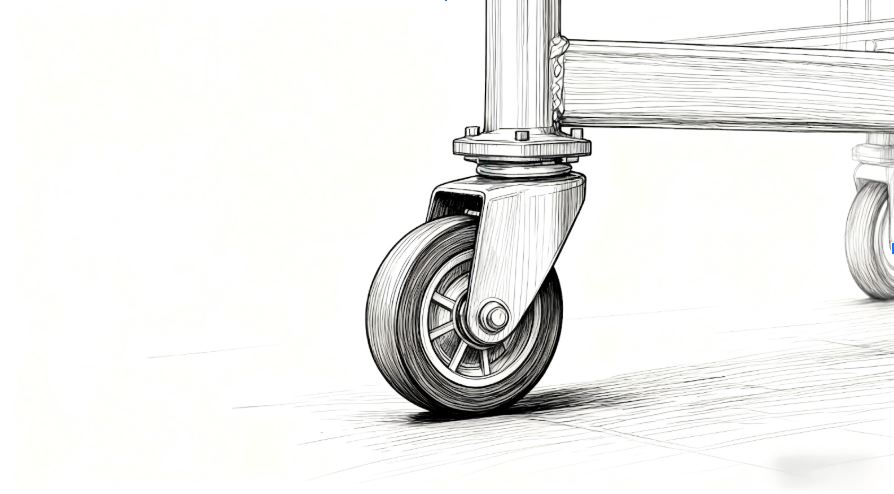Choosing the right casters for your equipment is essential for ensuring mobility, stability, and ease of use. Among the various types available, M10 stem casters stand out for their versatility and robust performance. This article will guide you through the process of selecting the right M10 stem casters for your needs, focusing on their features, applications, and tips for making the best choice.
Key Takeaways
- M10 stem casters are ideal for a wide range of applications, including furniture, medical equipment, and industrial machinery, thanks to their robust construction and load capacity.
- Key features to consider when choosing M10 stem casters include wheel diameter, brake type, overall height, and material, all of which impact performance and usability.
- Always ensure that the casters can support the weight of your equipment. M10 stem casters typically support up to 600 lbs (270 kg) for a set of four.
- Proper installation and regular maintenance, including cleaning and lubrication, are essential for ensuring the longevity and performance of M10 stem casters.
- Choose casters with locking mechanisms for added safety, especially in environments where equipment needs to remain stationary, such as in medical settings.
What Are M10 Stem Casters?
M10 stem casters are specialized wheels designed for a range of equipment, from furniture to medical devices. The “M10” refers to the size of the stem, which has a diameter of 10 mm and a thread pitch of 1.5 mm. These casters are commonly used in settings where mobility is essential, such as hospitals, warehouses, and offices.
Why Choose M10 Stem Casters?
M10 stem casters offer several benefits:
- Load Capacity: With a load capacity of up to 600 lbs (270 kg) for a set of four, they can support heavy equipment without compromising performance.
- Swivel Functionality: These casters can swivel, allowing for greater maneuverability in tight spaces.
- Durability: Made from high-quality materials, M10 stem casters are designed to withstand wear and tear, making them a reliable choice for any application.
- Versatile Applications: They can be used in various settings, including furniture, medical equipment, and industrial machinery.
Key Features of M10 Stem Casters
When selecting M10 stem casters, consider the following features:
1. Wheel Diameter
M10 stem casters typically have a wheel diameter of 3 inches (75 mm). This size strikes a balance between mobility and stability, making them ideal for a range of applications. Larger wheels can roll over obstacles more easily, while smaller wheels may offer better stability. For most applications, a 3-inch diameter is versatile and effective.
2. Brake Type
M10 stem casters often come with side brakes. This feature allows users to secure the caster in place when stationary, ensuring safety and stability, especially in medical equipment or heavy furniture. A secure lock caster for medical equipment, for instance, is crucial to prevent accidental movement during use.
3. Overall Height
The overall height of these casters is approximately 3.5 inches (88.9 mm). This low profile allows them to fit under furniture with minimal clearance, making them suitable for various settings, such as office environments and home furniture.
4. Material and Design
The wheel tread is usually made of Thermoplastic Rubber (TPR), which provides excellent floor protection and a smooth rolling experience. TPR is not only durable but also quiet, making it ideal for environments where noise reduction is essential. The design of M10 stem casters ensures that they can be easily installed and replaced, which is a significant advantage for frequent users.
Applications of M10 Stem Casters
M10 stem casters are versatile and can be used in various applications, including:
- Furniture Movers: These casters make it easy to move heavy furniture without damaging floors. Whether it’s a sofa, cabinet, or office desk, M10 stem casters provide smooth mobility.
- Medical Equipment: A secure lock caster for medical equipment ensures that devices remain stationary when needed, providing safety for patients and caregivers. Equipment such as hospital beds and carts can benefit immensely from the reliability of M10 stem casters.
- Warehouse Trucks: In warehouses, M10 stem casters facilitate the movement of goods, enhancing efficiency. They can handle the rigors of industrial environments, making them a preferred choice for material handling.
- Office Chairs: Swivel stem casters on furniture, such as office chairs, allow for easy mobility and comfort during work. This adaptability contributes to a more productive workspace.
How to Choose the Right M10 Stem Casters
Choosing the right M10 Stem Casters involves several considerations. Here’s a step-by-step guide to help you make the best choice:
Step 1: Assess Your Needs
Determine the specific requirements of your equipment. Consider the following questions:
- What is the weight of the equipment? Knowing the weight will help you choose casters that can effectively support the load.
- Will the caster be used on carpet, tile, or concrete? Different surfaces can affect the performance of casters. For instance, softer wheels are often better for hard surfaces, while harder wheels work well on carpets.
- Do you need a locking mechanism to secure the caster? If stability is a concern, especially for medical or heavy equipment, a locking mechanism is essential.
- Is maneuverability important in your workspace? If you work in tight spaces, swivel casters can enhance your ability to navigate around obstacles easily.
Step 2: Check Load Capacity
Ensure that the casters can support the weight of your equipment. M10 stem casters typically support up to 600 lbs (270 kg) for a set of four, but it’s essential to verify this based on your specific needs. Always consider the total weight, including the equipment and any additional loads that may be placed on it.
Step 3: Evaluate Wheel Diameter
The wheel diameter affects mobility. Larger wheels can roll over obstacles more easily, while smaller wheels may offer better stability. For most applications, a 3-inch diameter is versatile and effective, providing a good balance between ease of movement and load-bearing capacity.
Step 4: Consider Brake Options
If your equipment requires stability when stationary, opt for casters with a secure locking mechanism. Side brakes are often the best choice for both safety and ease of use. This feature is especially crucial in settings like hospitals where equipment must remain stationary for prolonged periods.
Step 5: Material Matters
Choose casters made from durable materials like TPR, which provide a smooth rolling experience and protect floors from damage. This is particularly important for environments like hospitals, where cleanliness and safety are paramount. TPR also offers excellent shock absorption, enhancing the comfort of movement.
Step 6: Installation Considerations
Make sure the M10 stem casters are compatible with your equipment. Most casters can be easily installed using standard tools, but check if any additional accessories, such as nuts or spanners, are required. Additionally, consider the mounting type—some casters are designed for stem-mount configurations, while others may use plate mounts.
Common Mistakes to Avoid
When selecting M10 stem casters, avoid these common mistakes:
- Overlooking Weight Limits: Always check the load capacity to ensure that the casters can handle the weight of your equipment. Underestimating the required capacity can lead to accidents and equipment damage.
- Ignoring Surface Type: Different surfaces require different types of wheels. For example, soft wheels are better for hard surfaces, while harder wheels work well on carpets.
- Neglecting the Importance of Brakes: If your equipment will be stationary for long periods, ensure you choose casters with brakes. This is particularly crucial in medical settings to prevent unintended movement.
Maintenance Tips for M10 Stem Casters
To ensure optimal performance and longevity of your M10 stem casters, consider the following maintenance tips:
1. Regular Inspections
Conduct regular inspections of your casters for signs of wear or damage. Look for cracks in the wheels or any misalignment in the stem. Early detection can prevent further damage and ensure safety.
2. Cleaning
Keep the casters clean to ensure smooth operation. Dirt and debris can accumulate, leading to resistance and potential damage. Use a damp cloth to wipe down the wheels and check for any obstructions.
3. Lubrication
Occasionally, apply lubricant to the swivel mechanism to ensure smooth movement. This is especially important if the casters are used frequently or in environments with heavy usage.
4. Check Fasteners
Ensure that all fasteners are tight and secure. Loose bolts can lead to instability and affect the performance of the caster.
5. Replacement
If you notice significant wear or damage that cannot be fixed, consider replacing the casters. It’s better to invest in new, high-quality casters than risk safety and functionality.
Frequently Asked Questions (FAQs)
What is the load capacity of M10 stem casters?
M10 stem casters typically support a load capacity of up to 600 lbs (270 kg) for a set of four, making them suitable for heavy equipment.
What surfaces are M10 stem casters suitable for?
M10 stem casters can be used on various surfaces, including tile, concrete, and carpet. The type of wheel material can affect performance on different surfaces.
Do M10 stem casters come with brakes?
Yes, many M10 stem casters come with side brakes that allow users to secure the caster in place when stationary, enhancing safety and stability.
How do I install M10 stem casters?
M10 stem casters can typically be installed using standard tools. Ensure compatibility with your equipment, and check if any additional accessories are needed for installation.
How can I maintain my M10 stem casters?
Regular maintenance includes cleaning the casters, inspecting for wear or damage, lubricating the swivel mechanism, and ensuring all fasteners are tight and secure.
Conclusion
Choosing the right M10 Stem Casters for your equipment is crucial for ensuring mobility and stability. By assessing your needs, checking load capacities, and considering wheel diameter and brake options, you can make an informed decision that enhances the functionality of your equipment. Remember to prioritize quality materials and installation compatibility to maximize the benefits of your casters.
Whether you need casters for furniture, medical equipment, or industrial applications, M10 stem casters are a reliable choice that combines performance, durability, and ease of use. With the right selection, you can improve mobility and efficiency in any setting.





























